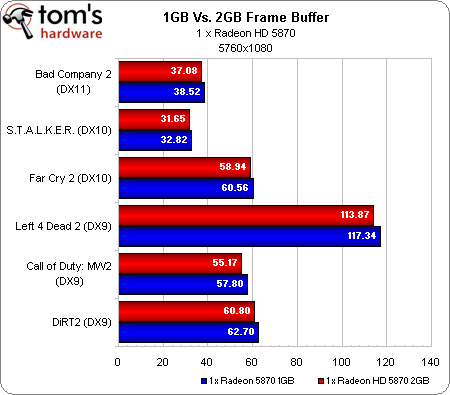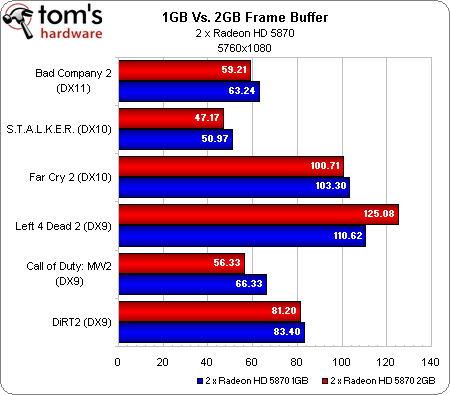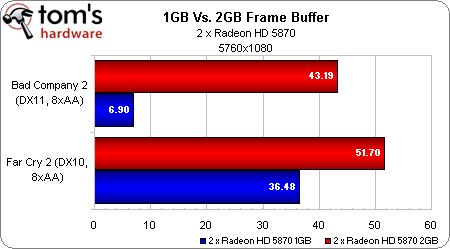AMD Radeon HD 5870 Eyefinity 6 Edition: One Card, Six Screens
Frame Buffer: 2GB Versus 1GB
Were you to buy a 2GB Radeon HD 5870 for three-monitor gaming, using the other three displays in a separate display group, you’d probably be curious about the benefits of a 2GB card versus a 1GB board, especially given the price premium.
We ran the same benchmarks at the same settings and 5760x1080 resolution and discovered that simply increasing the capacity of your frame buffer isn’t a guarantee of additional performance. We’ve seen this before, where the overhead of implementing a larger frame buffer causes a small performance hit in certain situations, so it’s hardly a surprise.
To the contrary, this is good news for folks running Radeon HD 5870 1GB boards, because it means they already have the rendering muscle needed to drive three 1920x1080 displays at playable frame rates.
Of course, there is a reason to step up from 1GB to 2GB (beside the obvious output connectivity increase). I picked a couple of the games that were running plenty-fast in the previous CrossFire chart and added 8xAA to them. As you can see, Far Cry 2 is significantly more playable, and Battlefield: Bad Company 2 goes from being a slide show to cranking along fairly smoothly. The key here is that you’ll have to exceed the limits of a 1GB card at settings that’d still otherwise be playable on a 2GB board. The rendering muscle of a second board in CrossFire is instrumental in delivering that extra “oomph.”
Get Tom's Hardware's best news and in-depth reviews, straight to your inbox.
Current page: Frame Buffer: 2GB Versus 1GB
Prev Page Three Monitors (5760x1080): One/Two Cards Next Page Power Consumption-
phantomtrooper I would hate playing with that much black area between screens. I will stick with my 1080p monitor thank you.Reply -
megamanx00 Glad they compared the 1GB and 2GB cards in a 3x1 setup. Glad I got my 5870 instead of waiting for a 2GB card :D. Even so, I want some thin bezel monitors before I hook up three of them. The bezel on my HP LCD is just to think so I'm not keen on buying another two.Reply -
duk3 http://www.newegg.com/Product/Product.aspx?Item=N82E16814125322&cm_re=5870-_-14-125-322-_-ProductReply
Immediate availability? Yes.
Even in stock! (When linked :P ) -
ltcommander_data So I guess Apple's miniDP connector is quite useful after-all and is now seeing adoption outside of Macs.Reply
It's too bad you didn't test GTA IV like you used to do. I believe GTA IV at max settings exceeds 1GB of VRAM usage so perhaps 2GB graphics cards may be of some use assuming the game isn't still CPU limited despite 12 threads with the Core i7 980X. At the very least, I'm guessing Liberty City at 6048x2276 would be amazing. -
oldscotch Obviously, the best solution is a 3x3 grid of displays to make sure your centre focus is not interfered with.Reply
Lesse, that'd be 5760 x 3240.
No sweat ;) -
So, I guess if you already have a 1GB 5870 and 3x1 Eyefinity setup, the only advantage of the 2GB version is being able to pile on the AA/AF effects and still have a playable frame rate.Reply



